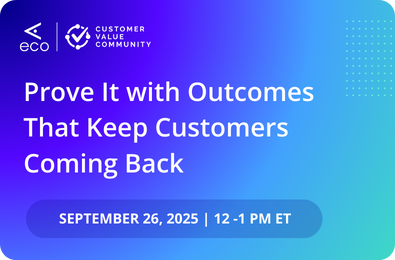In a recent Customer Value Community Sandbox event, members from top B2B companies had an in-depth conversation on what makes a great discovery process. During the event, they shared their top tips for conducting the discovery process that they follow at their organizations. Keep reading to learn more.
1. Make Value a Collaborative Conversation
When connecting with your customers on value, make it a fully collaborative experience. Instead of coming into the conversation with a set list of questions you need answers to, take a step back and give them a chance to speak on what is top of mind to them. Allow your customers to direct the conversation to get to the root of their desired business outcomes. By constraining the conversation to set criteria, you may miss out on important information and lose the chance to fully align stakeholders on value.
Through this conversation, you can then begin to align on tactics, metrics, targets, and timelines.
2. The Math is Last
Do not dive straight into ROI during the value conversation. Instead, prioritize understanding the why behind your customer's concerns. Starting the discovery conversation here will allow you to better align your offerings to their needs, making the ROI conversation more beneficial when the time comes.
By diving into the why first, you will be able to determine why the change needs to occur first, allowing you to better understand the value needed from your customer’s point of view.
3. Customers at Better Editors than Writers (Ecosystems Principle #6)
When diving into the business case and aligning on objectives in the discovery stage, take time to do your own research when entering into the conversation. You do not have to be the expert going in, but giving your customers a starting off point to discuss value internally and collaborate will lead to richer conversations. By getting them involved in the discovery process as an editor, they will take more ownership and feel more confident as a buyer in presenting the business case internally. To better empower your customers to be edits and collaborators, check out Ecosystems software platform.
4. Discovery is an Ongoing Process Owned by Everyone
It is easy to make the mistake of assuming that discovery starts and ends in the discovery process of a sales cycle. However, discovery can happen at any point in the sales cycle and before the sales cycle even begins. Every conversation your team has with a customer or prospect has the potential to glean critical information as new objectives arise. Due to this, starting each conversation with realigning on business objectives is crucial.
New objectives can emerge in any customer or prospect conversation, meaning discovery should be viewed as owned by everyone in the organization, from presales to sales, customer success, marketing, and value.
5. Using AI
AI can help benefit you during the discovery process, especially with research, as many top B2B organizations have begun to utilize AI for research purposes around their customers and prospects. Organizations are also using AI note-taking during meetings to ensure everything is captured accurately.
If you are looking to up-level your discovery process even further with the power of AI, check out ViViEN, the first-ever AI-powered Virtual Value Engineer which revolutionizes the way providers, partners, and customers collaborate to drive value. With ViViEN, you can research, compass, automate, and optimize value.
























